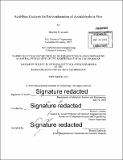| dc.contributor.author | Lusardi, Marcella R. (Marcella Rose) | en_US |
| dc.contributor.other | Massachusetts Institute of Technology. Department of Materials Science and Engineering. | en_US |
| dc.date.accessioned | 2016-03-03T21:09:13Z | |
| dc.date.available | 2016-03-03T21:09:13Z | |
| dc.date.copyright | 2015 | en_US |
| dc.date.issued | 2015 | en_US |
| dc.identifier.uri | http://hdl.handle.net/1721.1/101563 | |
| dc.description | Thesis: S.M., Massachusetts Institute of Technology, Department of Materials Science and Engineering, 2015. | en_US |
| dc.description | Cataloged from PDF version of thesis. | en_US |
| dc.description | Includes bibliographical references (pages 71-74). | en_US |
| dc.description.abstract | Acetaldehyde is used as a bio-oil model compound in a polycondensation reaction over two acid-base catalysts, pelletized Evonik P25 TiO₂ and an activated hydrotalcite-like compound (HTlc), to produce high molecular weight molecules in the transportation fuel range. The catalytic performance of these materials is evaluated in a gas phase, atmospheric flow system with a packed bed microreactor designed to mimic process conditions in one step of the overall bio-oil upgrading scheme. The HTlc is activated through calcination at 500 °C followed by rehydration in decarbonated H₂O, generating the active acid-base hydroxyl pairs. Materials are characterized through XRD, low temperature N₂ adsorption-desorption isotherm experiments, TGA, and XPS. In initial experiments, high conversions are achieved but all converted acetaldehyde forms carbonaceous deposits on the catalyst surfaces over a range of temperatures and residence times. When the catalyst bed is reduced by 80%, decreasing both residence time and vapor-solid contact area, high conversions are maintained and the production of liquid phase condensation products is observed on the order of seconds. While yields are low, it is promising that tuning the packed bed results in decreased deposits and generation of liquid phase products. Further adjustments of reaction parameters and catalyst activity are of interest as future work, including shorter residence times and bed lengths, co-feeding a reaction inhibitor, and specific catalyst syntheses for control over active sites. | en_US |
| dc.description.statementofresponsibility | by Marcella R. Lusardi. | en_US |
| dc.format.extent | 74 pages | en_US |
| dc.language.iso | eng | en_US |
| dc.publisher | Massachusetts Institute of Technology | en_US |
| dc.rights | M.I.T. theses are protected by copyright. They may be viewed from this source for any purpose, but reproduction or distribution in any format is prohibited without written permission. See provided URL for inquiries about permission. | en_US |
| dc.rights.uri | http://dspace.mit.edu/handle/1721.1/7582 | en_US |
| dc.subject | Materials Science and Engineering. | en_US |
| dc.title | Acid-base catalysts for polycondensation of acetaldehyde in flow | en_US |
| dc.type | Thesis | en_US |
| dc.description.degree | S.M. | en_US |
| dc.contributor.department | Massachusetts Institute of Technology. Department of Materials Science and Engineering | |
| dc.identifier.oclc | 940571125 | en_US |
